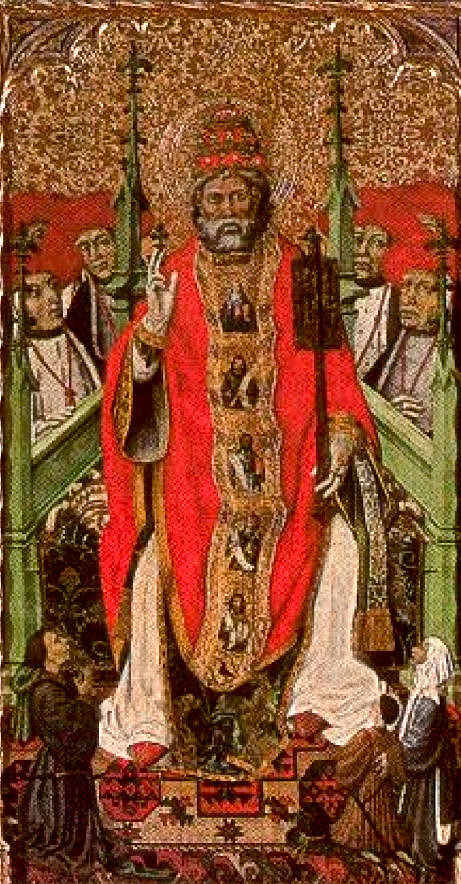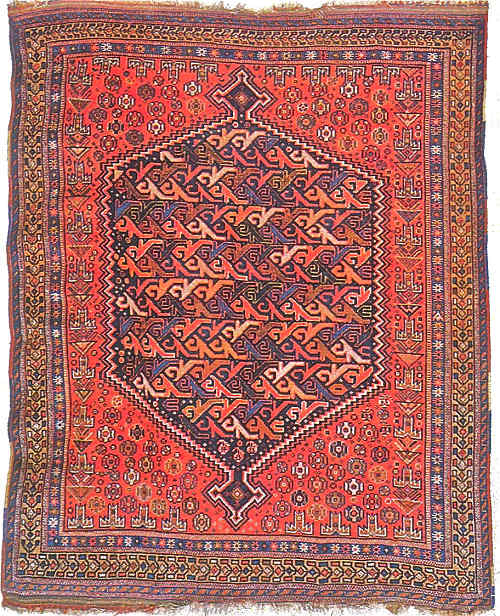|
|
|
|
#1 |
|
Members
Join Date: Nov 2009
Posts: 7
|
Noticed that fig. 61 of the Salon has the same border. B. Martorell, 1437-1442, St. Peter’s altar, Girona. Spain.
/ George |
|
|

|
|
|
#2 |
|
Administrator
Join Date: May 2008
Location: Cyprus
Posts: 194
|
Hi George,
The image has a very low resolution, but I think you are right!  Regards, Filiberto |
|
|

|
|
|
#3 |
|
Members
Join Date: Oct 2009
Posts: 153
|
Indeed, it could be identical.
I'll try to find a better view of Martorell's painting. Pierre |
|
|

|
|
|
#4 |
|
Members
Join Date: Nov 2009
Posts: 7
|
Pierre, found one:
 / George |
|
|

|
|
|
#5 |
|
Members
Join Date: Oct 2009
Posts: 153
|
Bravo, George!
That leaves the origin of this motif (or at least the place were this rug was woven), wide open: Anatolia ?, Caucasus ? (At the date of the painting the Black Sea was still easily accessible to Venetian / Genoan ships and Caucasian rugs could easily have been imported from there, via Trebzond or Tana) or Spain / Aragon (given the nationality of the painter and the claim by experts that Mudejar weavers frequently opted for yellow field backgrounds).  Best regards Pierre |
|
|

|
|
|
#6 |
|
Administrator
Join Date: May 2008
Location: Cyprus
Posts: 194
|
Hi Pierre,
The strange thing is that MET’s web page says The interlocking hooked motifs (probably stylized vines), in particular, connect it to later carpets from western Anatolia. I checked my copy of Uwe Jordan’s book “Turchi” and your database that has more than 500 examples of Turkish carpets: I didn’find a single example of this motif. And Stone mentions only Caucasus and Persia in relation to it. So, I had also a look at the Persian database. There I was luckier, I found this Afshar (Persian.Afshar.13.X IX.149X124.N314.jpg)  out of around 390 image. Here the motif is in the field. Regards, Filiberto |
|
|

|
|
|
#7 |
|
Members
Join Date: Oct 2009
Posts: 153
|
Hi Filiberto,
That's strange, yes, but one can safely assume that the MET owns a much larger data bank than us, mere "dilettanti".  The carpet which you illustrated was published in the catalog of the 314th Fritz Nagel Auction, 1986, # 3330. They attributed indeed the rug to the Afshar, end of XIX or early XX century. Their comment (loosely translated from German by your servant) is interesting, although it rather further increases the viscosity of the molasses: "At first sight, the strongly personal abstract field motif ....is reminiscent of the complex motifs of the Morgi clan of the Afshar.....Apparentl y the artfully imbricated motif represents simplified animals..". Nagel's expert sees also a strong analogy with two thirteenth century rugs published by Erdman in his "Geschichte des frühen türkischen Teppich", one was attributed to Konya (FIG 4) and the other is a fragment found at Beysehir (FIG 9). I don't own Erdman's book and can't check it, but perhaps these rugs induced the MET to attribute a Turkish passport to its own fragment? Anyway, this Caucaso-Perso-Turko-Mudejar  rug, is superb isn't? I 'd love to own it. rug, is superb isn't? I 'd love to own it.Best regards Pierre P.S. Congrats for your outstanding visual memory. |
|
|

|
 |
|
|